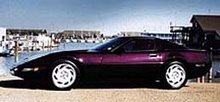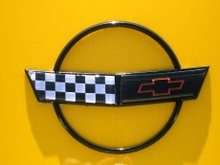Air Power Systems and DynoTech Engineering? Absolutely! And when you see their kick-ass twin-turbo setup for the C6, you'll understand why.
While it may not yet be a household name stateside, Air Power Systems (APS) is an Australian firm with over twenty years of experience in designing and manufacturing turbocharger and intercooler systems. APS also has an extensive background in EFI engine-management systems for select performance vehicles. APS officials tell us the company's signature lies in the quality and durability of its components, the attention to detail put into every system, and unswerving dedication to the notion that performance must always be reliably achieved.
DynoTech Engineering (DTE) is perhaps best known in the Corvette world for its innovative drivetrain fortifications. You've no doubt seen DTE's bright-red differential struts on the most serious Corvettes around. Located in Fort Wayne, Indiana, DTE also offers a broad array of powerful forced-induction performance packages for GM vehicles.
With the introduction of the APS twin-turbo system for the C6, a new performance era is upon us. Follow along as DTE guides us through the finer points of the install. As you'll soon see, the APS system is not only brutally powerful but also an aesthetically pleasing performance package.
Twin-turbo systems are nothing new to Corvettes, but the APS system bears the distinction of being the first one available for the C6. The turbos are obviously the star of the show, and the APS units come loaded for bear. The system's foundation is a pair of twin-ball-bearing, water-cooled Garrett turbochargers. Traditional turbochargers employ a bearing supported by a film of oil that forms a cushioning layer between it and the turbocharger shaft. The shaft relies on a constant supply of fresh, clean oil over a very wide contact area in order to maintain sufficient clearance from the bearing itself. A similar approach is used to isolate the main shaft from thrust loads. Though this design is simple and fairly reliable, high friction results in sluggish turbocharger response, or lag. Unlike standard turbos, ball bearings are utilized on both sides of the APS turbo's main shaft, doing away with the typical floating bearings. The design is robust and compact in size. The opposed, angular, contact-bearing cartridge eliminates the need for a thrust bearing, which is commonly a weak link in standard turbos.
Water-cooled center sections are not a new innovation, but they are gaining popularity due to their reliability. With traditional turbos, engine oil provides both lubrication and cooling. This is an effective compromise between cost and performance, but in high-performance applications, durability can suffer. By enclosing the turbo's bearings in water passages, engine coolant is used to reduce turbocharger-bearing temperatures. This practically eliminates oil coking and lacquering, which can foul the bearings in standard turbochargers. The water-cooled bearings of the APS turbos remain cooler than the oil's coking-threshold temperature at all times, virtually eliminating the problem.
Another advantage of the dual-ball-bearing design is that it requires less engine oil to provide proper lubrication for the turbo. This reduces the load on the engine's oil pump, allowing more oil volume to vital engine components for improved engine durability. The oil flow through the turbocharger is controlled by an oil-flow control module that also serves as a debris separator to keep foreign particles from entering the bearing assembly. Frictional losses with ball-bearing turbochargers are reduced by 40-50 percent as compared with a conventional turbo. The improvement in turbocharger response, particularly in the low- and mid-turbocharger-speed range, is quite evident from the driver's seat.
The additional plumbing associated with turbochargers has always contributed to elevated engine-bay temperatures. APS solved this problem by positioning the turbos up under the chassis, away from the engine compartment.
Each turbo is equipped with its own blow-off valve (BOV). The BOV is designed to release boost pressure from the turbocharger when the throttle is quickly closed. It prevents the formation of a pressure-shock load on the turbocharger compressor and allows the turbo to continue spinning freely during gear changes. This ensures that as the next gear is grabbed and the throttle mashed, the turbos spool quickly and provide near instantaneous boost. APS has designed a lot of performance headroom with these turbos. So much, in fact, that they can support (with a built engine) approximately 1,000 hp at just 15 psi of boost.
When air is compressed-in this case by the turbocharger-it is also heated. An intercooler's function is to lower the charge-air temperature as close as possible to ambient. This enhances power production because cool air contains more oxygen, which means more fuel can be added. And you know what that means: more power and more sh*t-eatin' grins for the driver. Accordingly, APS provides a pair of vertical-flow, high-efficiency intercoolers utilizing lightweight, cast-aluminum end tanks. Intercooler performance is measured by the amount of heat the unit can remove from the inlet-charge air as well as the pressure drop across the entire system. Each APS core measures 10x11x4 inches, and the claimed pressure drop is less than 1.0 psi. As for efficiency, the intercooler-outlet temperature is less than 15 degrees higher than ambient at any vehicle speed over 50 mph.
The APS intercoolers use bar-and-plate core construction for the highest flow and greatest efficiency possible. This type of construction results in an inherently strong intercooler core of high thermal inertia, which means they have massive reserves of cooling capacity. This is important in situations where ambient airflow over the core is low, such as the time between the burnout and launch at the dragstrip.
The intercoolers' design allows retention of the stock air-conditioning system with no degradation of performance. The use of two separate intercoolers allows a generous air gap to channel ambient airflow into and through the air-conditioning and engine-cooling radiators.
Exhaust gases that feed each turbocharger must arrive at the turbine with the maximum amount of gas energy possible. This ensures crisp turbocharger response and high horsepower.
APS designed its High Energy Turbo exhaust manifolds to achieve the ultimate in terms of gas/energy transfer and outright performance. Cast in high-temperature ductile iron, the APS exhaust manifolds are built to withstand extreme horsepower levels. They have been designed to maximize flow and close-couple the turbine housings to the exhaust ports, making for the most efficient transfer of exhaust-gas energy possible. Cast manifolds perform this function much better than any fabricated solution. This is particularly important under spirited driving conditions that require frequent periods of on/off throttle, such as on a road course or during an autocross event. Notice the threaded bosses for heatshield attachment.
APS provides engine-management program data on CD for download into the stock computer. The APS data is designed for 93-octane fuel in an otherwise-stock, LS2-engined C6 Corvette. The stock ECU is reflashed using the popular HP Tuner. The reflash can also be performed by the tuner of your choice with HP Tuner's software. In the case of our yellow convertible, DTE proprietor Phil Rickard performed a full-blown custom tune on the car on his shop's in-house dynamometer. Rickard has extensive experience with forced-induction Corvette applications (he cut his teeth working on Lingenfelter's twin-turbo program in the late '90s) and was able to pull considerably more power out of the car than would have been available with the "generic" APS programming. Given the extensive-and expensive-nature of the APS turbo upgrade, we'd consider a custom tune such as this mandatory for maximum power and reliability.
Complete article can be found on Vette magazine.
Sunday, January 14, 2007
Subscribe to:
Posts (Atom)












